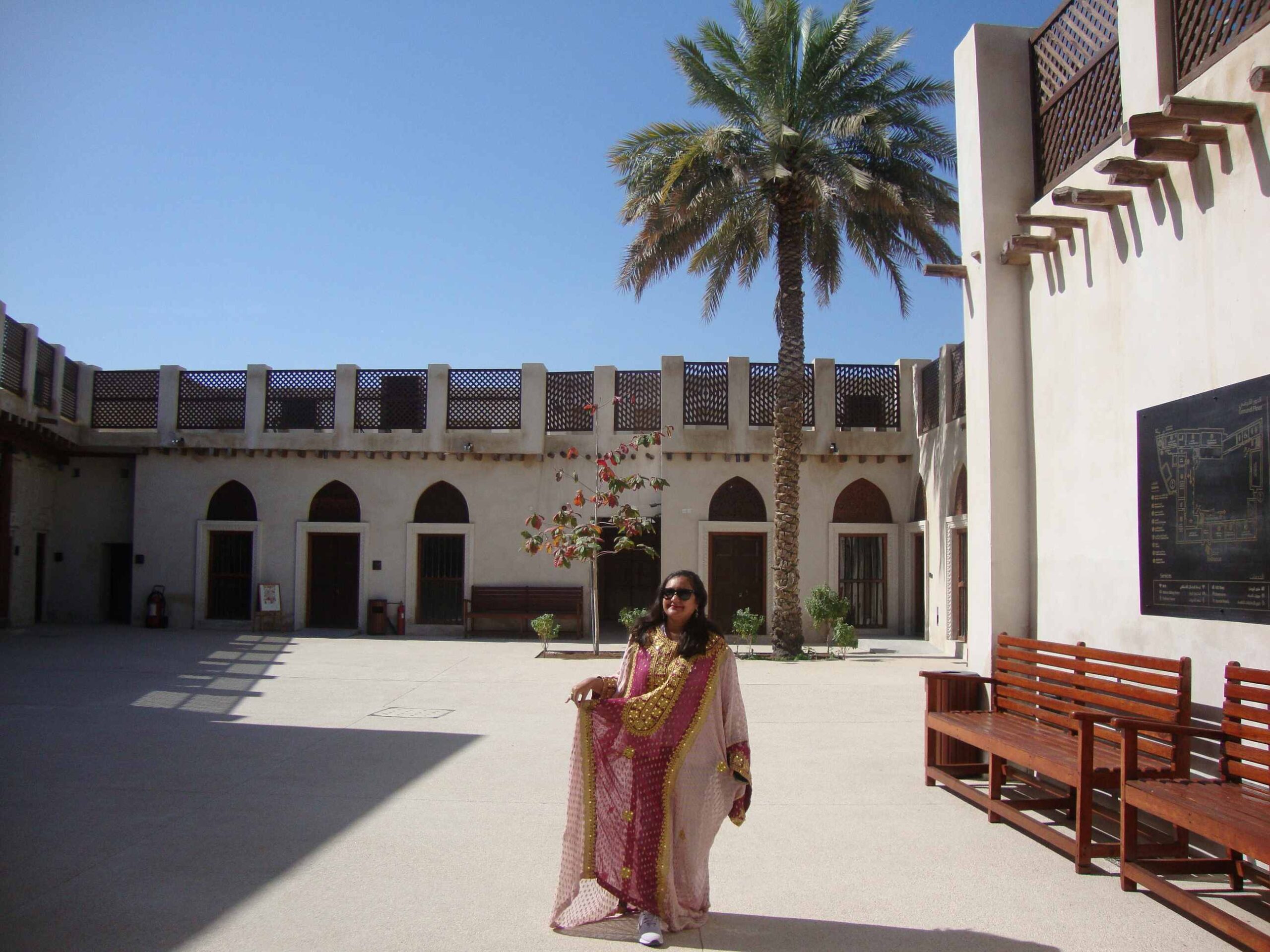On a balmy morning, we land in the Emirate of Sharjah and were pleasantly surprised to feel a chill in the air as we stepped out of the Air Arabia flight from Delhi – an unlikely welcome in a desert town to wake us up. As we look around, a towering minaret near the airport catches the eye, where the call for a morning prayer (Adhan) is announced for everyone to pause and pray. Popular as the “Islamic culture capital” and named by UNESCO as “The Arab capital of culture,” there are more than 2,000 big and small mosques across this Emirate in UAE. The signature Islamic architecture and patterns on these holy monuments are typical to the region, and as we drove across the various landscapes here the uniformity in the structures was hard to miss.
Sharjah Light Festival
We are here to witness the 12th edition of the annual Sharjah Light Festival, where renowned artists participate to create amazing light installations at beloved landmarks like mosques, dams, and forts. The 12-day festival celebrates the local heritage and culture with colourful lights, music, and art that accentuate select buildings and landmarks and transform them into stunning works of art using light and projection mapping technology. The festival typically takes place in February each year and attracts visitors from around the world and features large-scale light installations and interactive displays to enhance the city’s reputation as a destination for creativity and innovation.

As the sun goes down, the cold evenings glow with the artistic beauty of light projections over holy mosques like Al Noor, Sharjah Mosque, and heritage sites like Sharjah Fort (Al Hisn), Al Majaz Waterfront, Al Rafisah Dam and Kalba Clock Tower. Many residents gather around to watch the colourful play of designs that cover the surface and observe the storytelling with orchestral music which makes it a unique immersive sensory experience for all age groups.
On a cultural quest:
Sharjah city is a wonderful contrast of the new and the old cultural settings and has some remarkable touristy spots for people interested in the history of the Arabic lifestyle. There are 16 renowned museums in the city, and some of them are sites of historical significance that are now packed with information and well-preserved memorabilia. A must-visit is the Al Mahatta Museum, located in the center of the city and translated to “the station” in Arabic. It was built as a fort by the Ruler of Sharjah in 1932 to afford protection for the passengers and staff of Imperial Airways. It was the first British establishment on the Trucial Coast, and was used by the Royal Air Force in World War II and the Trucial Oman Scouts before briefly becoming a hotel, and a police station and is now an aviation museum. For any aviation or vintage machine lover, this is nothing less than a paradise full of old-world aircrafts, transportation devices, and collectibles from the bygone era.
The next stop on my list was the restored house of a rich pearl merchant now turned into a museum called Bait Al Naboodah, meaning the house of Naboodah. Located in the Heart of Sharjah, this heritage property is a fine example of an old-school Arabic house built around a courtyard with palm trees and wooden pillars that were imported from India. The Arabic merchant Naboodah, was a wealthy and influential man who traded natural pearls in the UK, France, and India, particularly with the legendary Maharajahs and Maharanis of erstwhile kingdoms. He chose a strategic location near the old souk (market) for building his home and traded from his guest area, which is called a majlis in the local language.
On a visit to this house, one can experience traditional Arabic hospitality with sweet dates and fragrant coffee that’s made fresh by grinding Brazilian beans with saffron, cardamom, and rose water. Guests can also try out some traditional wear for photo-ops and learn about the rituals of Emirati hospitality with local hosts, who are very warm and welcoming. For modern shoppers, a stroll at the new gold souk for jewellery and the old souk to purchase fabrics, traditional ittars, abayas, and cotton kandora (traditional long shirt worn by Arab men) is the best option. A stop at the Sharjah Art Foundation’s unique water installation the Rain Room is worth exploring for a day-out trip.
Nature’s delight:
As the Emirate is surrounded by the widespread Arabic Desert, it is very common for the locals to take little getaways in the never-ending sand spaces for a safari or an adventure on the dunes. In Meliha, we get to explore the crazy rollercoaster car rides on shape-shifting dunes in a powerful 4×4 vehicle that takes us through the fossil mountains and archeological sites. It is believed that post excavations, the evidence of underwater rocks and marine life forms were discovered by the locals and the area is under conservation for studies and protection of natural habitat.
Whereas, on the East coast lies the port city of Khor Fakkan, which faces the Gulf of Oman and is a popular spot among tourists due to its white sand beaches and coral reefs. The cornice road connects to the glamping resort Mysk Kingfisher Retreat located in the wild habit, where local birds, gazelles, turtles, crabs, and other interesting fauna are nestled amidst conserved mangroves. Surrounded by the Hajar Mountain range, the port city is also famous for the Al Rabi hiking trail that takes you to the top for a breathtaking view of the coastal area. A note worthy stop in Khor Fakkan is the Greek-Islamic-style amphitheater and a man-made waterfall adjacent to it, which lights up after sunset as the coastal promenade starts buzzing with locals.
(The writer is a Delhi-based journalist who writes on travel and luxury. Reach her at newspeakwork@gmail.com )
